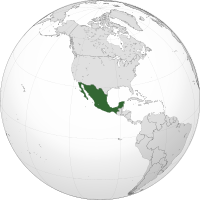The country of Mexico is located in North America, just below the United States of America.

(from: wikipedia - mexico)
The language in Mexico is Spanish.
Mexico City has the most people of any city in North America, with over 21 million,
and is in the top 10 most populated cities in the world.
A long time ago in Mexico there were other people called the
Aztecs and the Mayans who built some huge pyramids.
In a city called Chichen Itza there is a pyramid about 100 feet tall.






